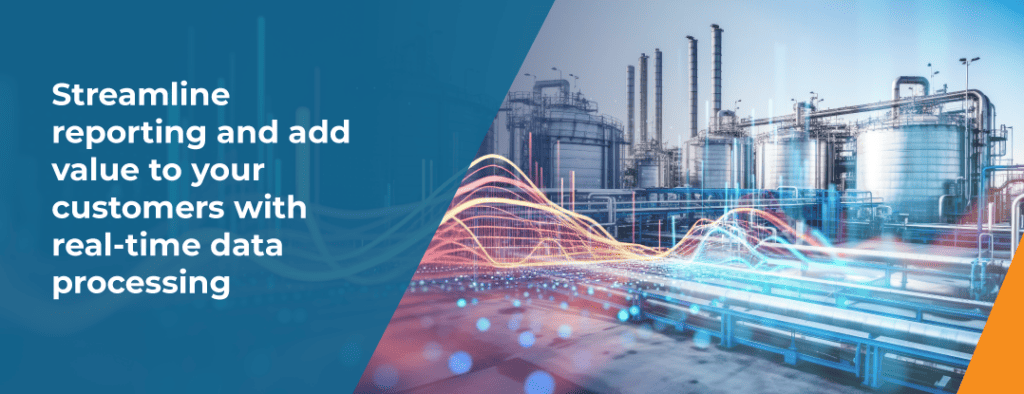Modernize Reporting and Add Customer Value with Real-Time Data Processing

Data, as they say, is the new gold. It’s almost infinitely valuable, providing the inputs and insights required to compete in today’s complex digital environment. All data, however, is not created equal. To take full advantage of the many ways data can drive your business, it must be accurate, reliable, and available in real time.
For oil and gas operators, meeting these criteria has historically been difficult. The industry has long relied on plugging numbers into Excel to process data, which is slow, manual, and error-prone. Legacy homegrown systems automate more of the data processing load, but come with their own issues, from maintaining outdated code bases to aging out staff. Neither of these options enable operators to process data quickly and precisely, nor do they empower businesses to share data with their own customers to build trusting relationships and hone competitive edge.
Fortunately, the latest ERP technology addresses many of these challenges. With a modern ERP solution built specifically for oil and gas, managing volume data has never been easier.

As the oil and gas industry has expanded and evolved, so has its transportation arm. More pipelines and terminals being built translates to a much more competitive market in which operators must contend for customers and revenue. Contract terms are growing more complex as well. With more options, buyers are asking for bigger, better deals with specific conditions and requirements. Plus, we’ve all become accustomed to instantaneous information in our personal and professional lives. With so much data constantly at our fingertips, receiving a paper report once a month feels decidedly antiquated.
Traditional data processing methods struggle to keep up with this new landscape. Different approaches face different challenges, including:
- Processing data manually with Excel. Many smaller organizations rely on Excel to compile and process volume data. This manual process is very time and resource intensive, with a high rate of human error and issues with audits. It often results in delays and missed deadlines, which affect cash flow, damage relationships with customers, and incur an influx of customer complaints.
- Running a legacy homegrown system. Larger organizations, on the other hand, often rely on proprietary systems that they built in-house years ago on now-outdated programming languages. Not only have the business requirements and use cases changed over the last decade(s), these systems must be maintained – “care and feeding,” as IT teams say. This, too, takes time and resources, and simply isn’t sustainable. Legacy systems are a liability for M&A activity as well. It’s far easier to sell an asset if the technology behind it is commercially available.
- Using a market available ERP system to streamline data processing. A third group of oil and gas businesses has upgraded to more modern data processing software. This is definitely a step in the right direction, but comes with its own problems.
Some popular solutions lack flexibility, forcing users to follow the system’s business logic model instead of their own. This quickly becomes cumbersome, especially as deals get more complex. Soon, you’re spending almost as much time reformatting the data to get into the system as it takes to process manually, or just continuing to run it outside the system because it can’t handle that setup. Further, some data processing tools get bogged down under the load of millions of transactions, requiring dedicated periods during closing where system access must be limited or unavailable.
While these approaches vary, they all maintain the status quo: stale data and infrequent processing. Oil and gas organizations need a way to process volume data quickly and effectively so they can save time, increase accuracy, make informed decisions, and share the latest data with their own customers.

The good news: Not all software solutions struggle to accommodate the complicated needs of the oil and gas industry. The W Energy ERP platform operates in near real time, running processes in minutes or hours instead of days or weeks. By running processes and getting volumes daily, you have far more insight into your operations. No more shutting down for five days every time you close the books and trying to crunch all of your processing into that week. Instead, you have an always-on pulse of your business.
In addition, the W Energy platform is inherently flexible. You tell the system how your pipeline should work, not the other way around. Its dynamic app configurations allow you to set up multiple unique pipelines, so the system can handle every deal that comes your way.
Immediate access to real-time data empowers your team to make of-the-minute, fully informed decisions. But it does more than streamline internal operations – it’s a huge selling point to your customers. With a platform like W, you can provide your customers with a Customer Activity Portal where they can see the latest data as soon as you run it. This gives them the knowledge they need to run their business more effectively, and makes you a unique, valuable asset in a crowded, competitive landscape.
The days of once-a-month reports are behind us. Provide better customer service, gain a competitive edge, and accelerate and improve internal reporting with real-time data processing from W Energy.

Author: Michael Ferrante, VP of Transportation
Michael earned a B.S. in business administration from Oklahoma State University. Since joining our team, he has helped build various modules within our software, ranging from marketing to gas balancing to land administration. Michael has lead implementation projects in many business areas of the industry and is currently focused on expanding the Transportation practice area with new pipeline and terminal clients.

Subscribe to Our Insights
Be the first to access blogs, case studies, videos, and more from our experts.